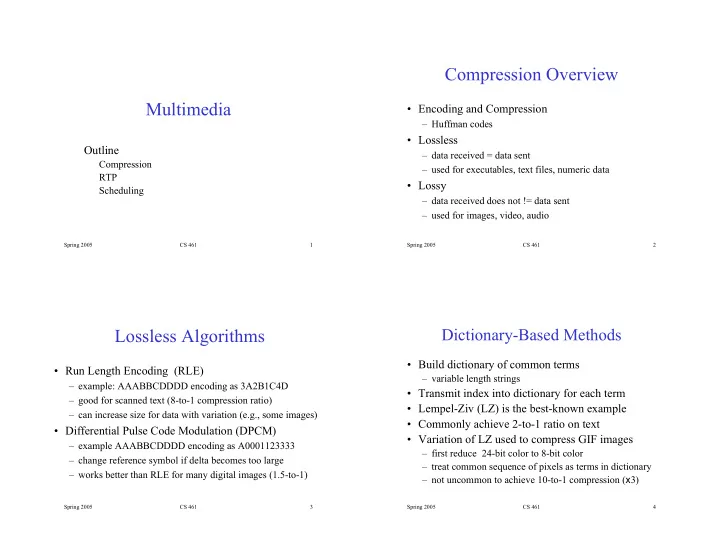

Compression Overview Multimedia • Encoding and Compression – Huffman codes • Lossless Outline – data received = data sent Compression – used for executables, text files, numeric data RTP • Lossy Scheduling – data received does not != data sent – used for images, video, audio Spring 2005 CS 461 1 Spring 2005 CS 461 2 Dictionary-Based Methods Lossless Algorithms • Build dictionary of common terms • Run Length Encoding (RLE) – variable length strings – example: AAABBCDDDD encoding as 3A2B1C4D • Transmit index into dictionary for each term – good for scanned text (8-to-1 compression ratio) • Lempel-Ziv (LZ) is the best-known example – can increase size for data with variation (e.g., some images) • Commonly achieve 2-to-1 ratio on text • Differential Pulse Code Modulation (DPCM) • Variation of LZ used to compress GIF images – example AAABBCDDDD encoding as A0001123333 – first reduce 24-bit color to 8-bit color – change reference symbol if delta becomes too large – treat common sequence of pixels as terms in dictionary – works better than RLE for many digital images (1.5-to-1) – not uncommon to achieve 10-to-1 compression ( x 3) Spring 2005 CS 461 3 Spring 2005 CS 461 4
Quantization and Encoding Image Compression • Quantization Table • JPEG: Joint Photographic Expert Group (ISO/ITU) 3 5 7 9 11 13 15 17 • Lossy still-image compression 5 7 9 11 13 15 17 19 7 9 11 13 15 17 19 21 • Three phase process 9 11 13 15 17 19 21 23 11 13 15 17 19 21 23 25 JPEG compression 13 15 17 19 21 23 25 27 Source Compressed image image 15 17 19 21 23 25 27 29 DCT Quantization Encoding 17 19 21 23 25 27 29 31 • Encoding Pattern – process in 8x8 block chunks (macro-block) – grayscale: each pixel is three values (YUV) – DCT: transforms signal from spatial domain into and equivalent signal in the frequency domain (loss-less) – apply a quantization to the results (lossy) – RLE-like encoding (loss-less) Spring 2005 CS 461 5 Spring 2005 CS 461 6 MPEG (cont) MPEG • Frame types – I frames: intrapicture • Motion Picture Expert Group – P frames: predicted picture – B frames: bidirectional predicted picture • Lossy compression of video Input Frame 1 Frame 2 Frame 3 Frame 4 Frame 5 Frame 6 Frame 7 • First approximation: JPEG on each frame stream • Also remove inter-frame redundancy MPEG compression Forward prediction Compressed I frame B frame B frame P frame B frame B frame I frame stream Bidirectional prediction • Example sequence transmitted as I P B B I B B Spring 2005 CS 461 7 Spring 2005 CS 461 8
MPEG (cont) MP3 • B and P frames – coordinate for the macroblock in the frame • CD Quality – motion vector relative to previous reference frame (B, P) – 44.1 kHz sampling rate – motion vector relative to subsequent reference frame (B) – 2 x 44.1 x 1000 x 16 = 1.41 Mbps – delta for each pixel in the macro block – 49/16 x 1.41 Mbps = 4.32 Mbps • Effectiveness • Strategy – typically 90-to-1 – split into some number of frequency bands – as high as 150-to-1 – divide each subband into a sequence of blocks – 30-to-1 for I frames – encode each block using DCT + Quantization + Huffman – P and B frames get another 3 to 5 x – trick: how many bits assigned to each subband Spring 2005 CS 461 9 Spring 2005 CS 461 10 RTP Transmitting MPEG • Adapt the encoding • Application-Level Framing – resolution • Data Packets – frame rate – sequence number – quantization table – timestamp (app defines “tick”) – GOP mix • Control Packets (send periodically) • Packetization – loss rate (fraction of packets received since last report) • Dealing with loss – measured jitter • GOP-induced latency Spring 2005 CS 461 11 Spring 2005 CS 461 12
Layered Video Real-Time Scheduling • Layered encoding • Priority – e.g., wavelet encoded • Earliest Deadline First (EDF) • Receiver Layered Multicast (RLM) • Rate Monotonic (RM) – transmit each layer to a different group address • Proportional Share – receivers subscribe to the groups they can “afford” – Probe to learn if you can afford next higher group/layer – with feedback • Smart Packet Dropper (multicast or unicast) – with adjustments for deadlines – select layers to send/drop based on observed congestion – observe directly or use RTP feedback Spring 2005 CS 461 13 Spring 2005 CS 461 14
Recommend
More recommend